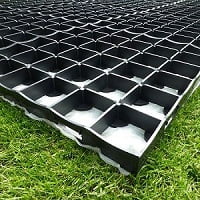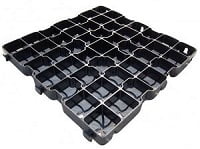A Base for your Corner Summerhouse
Whatever corner summerhouse you choose and wherever it is to be sited you’ll need to give some thought to what type of base to place it on. A suitable base is important for several reasons; it provides stability, helping to prevent the structure of the building sinking or distorting, it helps to protect the timbers of your summerhouse from ground level damp and collecting rainwater, (particularly desirable in the British climate!) and it should provide a visually pleasing, weed free foundation for your new garden building. Take a look at our summary of options below.
Pre-formed Summerhouse Bases
Featuring a heavy duty yet lightweight design the ProBASE modular system will provide a strong stable base in 500 x 500 mm units – superb load bearing qualities even when empty
A lighter base system, the Ecodeck is ideal for the smaller corner summerhouse where economy is important
A strong pre-formed modular base system formulated in recycled plastic 500 x 500 mm grids, the Ecobase Fastfit is versatile and ideally suited to a corner summer house
Wooden Base Kits
You can find a selection of wooden base kits available online from the following sellers
Transparency Statement
At no cost to you (none at all) some of the sellers listed in our price guides make a payment to us if you buy from them via our site. Not all sellers do and it doesn’t affect whether we list a seller on the site – it does however help to maintain the site and to keep it free to the user. You can find further information in our Privacy and Cookie Policy
Corner Summerhouse Base Options
When it comes to summerhouse bases there are a few options for you to consider. You could build your own base using paving slabs on a sand/cement base. Done properly, this should result in a level, strong free draining base we think it’s a good DIY option, particularly for a smaller summerhouse. There are a number of online guides available to help you do this. In our view the pick of the bunch are Waltons’ downloadable brochure and B&Q’s excellent online video. These refer to shed bases but they’re equally suitable for summerhouses. By the way, these and the following links all open in new tabs so keep an eye out for the new tab when you click on the link.
Bear in mind that in addition to the paving slabs and substrate material you’ll need a number of tools to construct the base properly. And laying paving slabs can be quite hard work, especially if the slabs and/or the summerhouse are on the large side. Although it all looks ginger peachy in the guides, experience has shown that to get each slab absolutely level and lined up, if you’re not experienced in this type of work you’re quite likely to have to lay and lift it two or three times. That can effectively double or treble the work! Check out Wickes’ range of paving to give you an idea of the type of slab you can buy along with details of sizes and prices.
Another base solution is the solid concrete base. Again there are quite a few online guides to show you how to do this – of which we’d particularly recommend Waltons’ brochure and two very comprehensive videos from the House Spouse which you can view here and here (again all these links open in new tabs). We’d commend the videos in particular as they show very clearly the various steps involved in constructing the base along with the materials and tools required.
At first glance the construction of a concrete base can look a bit scary – but it is something which can be completed by a reasonably compentent and fit diy’er with the correct equipment. Just follow the steps logically and don’t try to take any short cuts. Unless your summerhouse is very small we’d suggest you hire a cement mixer to mix concrete for the base. You should be able to do this locally at fairly economic rates. Have a look at National Tool Hire Shops (new tab again) for some ideas. And if you come to the conclusion that a concrete base is what you need but you really don’t want to take the job on yourself, you can always sound out a local builder for a quote – although that might not work out economically unless you have a large summerhouse – and a budget to match.
A third solution is to construct a wooden base consisting of heavy duty support timbers situated between the summerhouse floor and the ground. For more ideas how to do this we’d again recommend Waltons’ downloadable brochure which is pretty comprehensive as to what you need and how to do the job. A wooden base will only really provide adequate support for a smaller, lighter building and we wouldn’t recommend it ahead of the paving slab or concrete option, partly because the support timbers will be in permanent contact with the ground and liable to deteriorate over time. If you do decide to go for this approach we’d strongly recommend you look for impregnated timber to construct the base to ensure maximum durability. A number of retailers sell wooden shed base kits online – take a look at the selection above to get an idea of what’s currently available.
Finally, you could opt for one of the pre-formed bases available online today. These may work out a little more expensive than, say, a paving slab base, but they do have several advantages. In general a pre-formed summerhouse base will consist of relatively lightweight modules formed in plastic (often recycled). These are easily managed and laid to cover the desired area. Once filled with suitable aggregate a pre-formed base will provide support for even a heavy garden building and will offer decent drainage and good resistance to attack by the elements. The versatility of the modular construction means the base can be easily laid to the size and shape you need. We’d certainly recommend a pre-formed base as a relatively straightforward and trouble free solution as to how to form a good foundation for your corner summerhouse. We take a look at a few widely available models above.




